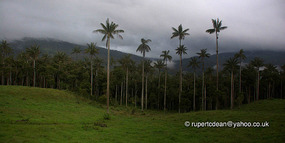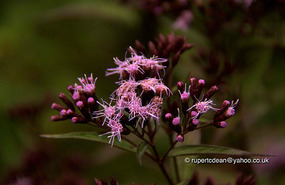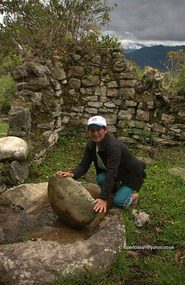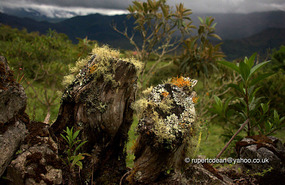Leaving Lima again at the crack of dawn was nice. The city seems to have changed little since we first arrived six weeks ago and is endlessly cold, damp and misty at best or foggy at worst. Friendly hostel though is great and always friendly and its nice to meet the procession of Peace Corps volunteers from the US and other interesting guests.
Having said all that it was great to get back in the skies, fly back over the Andes and drop down quickly to land in Tarapoto and the edge of the jungle
. The heat was a relief and as promised Edwin with his suspension-less taxi was there to meet us. He drove us the 70 odd kilometres to Moyobamba which is the capital of the San Martin provence where we had decided to break the journey to Chachapoyas.
Moyobamba and in fact the rest of San Martin was quite different to what we had seen in Southern Peru. From the taxi window it looked much cleaner in appearance and it also seemed well organised. This a major rice producing region and as a result looks more like Asia than Latin America. Clean streets, good roads, neat rice paddies, the occasional bull ploughing etc etc. Edwin stopped briefly for both of us to buy some fresh jungle fruits and a coconut.
Moyobamaba is the capital of Sam Martin and was bustling and friendly. We were staying with large affable Alfonso at his El Portion guesthouse in the centre of town
. It was really just two rows of motel like accommodation centred around some neat gardens with hammocks. It was very welcoming and I immediately felt comfortable there. Parrots and Saddle Backed Tamarind monkeys visited the garden throughout the day which was very nice.
He also had some nice guests, which included the San Martin Presidential Candidate for the up and coming elections. Carlos turned out to be a very nice charming man and despite a thorough grilling from Dad, appeared relaxed and unflustered.
Dad and I agreed that we should speed onto Chachapoyas and that we would return to Moyobamba should we have some time left at the end of this part of our trip. The next morning, we left with a taxi sent from Chachapoyas, by my friend’s tour company there. This second taxi driver spoke little English and his car was even more uncomfortable than Edwin’s but there was little we could do at this stage
.
Off we went from Moyobamba and we started the climb up to Chachapoyas. This was to be a six hour trip of breath taking beauty leaving behind the rice paddies and patches of lush jungle and driving through the windy mountain passes of the Andes and the famous cloud forests of the Alto Mayo. The road just got increasingly windy, with the drops increasingly precarious the further up we went. Unfortunately this driver hardly slowed down and instead seemed to be content on racing other cars up the mountain roads, ignoring the regular speed limits.
Finally we came out near the top of the 2,000m high passes and we started racing through some small Andean farming settlements. It was in one of these that we came around a corner into a village only to find a motor taxi (a tuk yuk) blocking the road. Our driver managed to swerve past the car (we were going far too fast) and then lost control and we careered off the road into the concrete drainage system, damaging both the side of the car and the undercarriage. Luckily no one was hurt, but the car was not in a good way and after he had finished verbally abusing the motor taxi driver and asking for money, we realised the car steering did not appear to function.
With no available signal on the mobiles, Dad and I left him under the car and walked around the village
. Strangely though after 15 mins he was waiving us back to the car. The car now seemed to be able corner, albeit with a rather disturbing noise emanating from underneath. We decided to give it ago and insisted that he reduce the speed.
Back in the car the winding roads took on a more ominous character now and we both sat in the car listening to complaints coming from under carriage as the driver navigated these difficult bends. Soon enough we go to Pedro Ruiz, the transport hub at the north of the Utcubamba Rio Valley en route to Chachapoyas. A further 50 Km through the scenic valley we left the road shadowing the river in the amazingly narrow valley and starting the climb to Chachapoyas at 2500m. Eventually we swung into the cobbled streets of Plaza del Arms and stopped (screeched to a halt) in front of the Hostel de Amazonas.
This was where I had stayed on my last two visits and both Eduardo (the owner) and Carlos (the owner of the Chapoyas Tour Company) were there too meet us. Both of them instantaneously remembered me and there were handshakes all around. We ambled into the striking old hostel with its 17th century architecture and Eduardo showed us our rooms. It was all pretty much the same as before, but all the twenty or so rooms were now available. Dad got the room I used to enjoy with its large room and adjacent bathroom. I spoke with Carlos and told him about the driver who had crashed en route and mentioned what we wished to do for the next few days. Dad had a long chat with Eduardo before we went out to get some dinner. We ambled over the square to another restaurant I used to frequent and then up the back of Chachapoyas to the old coffee shop. Everything was very similar to how I remember it, except the Chachapoyas had been cleaned up and many of the streets we now paved and not dirt. This was a great improvement. However the mist was still there.
The next day we decided to relax, organise the trips in the area and visit the local museum. It did not take long to organise the trips which I wanted to do with Carlos, but the museum turned out to be closed for the weekend (?!). We decided to have a long lunch instead and found another full restaurant on the opposite side of the Plaza Del Armas. We managed to squeeze inside with the locals underneath the plastic corrugated roof in the old hacienda (which was somewhat similar to Eduardo’s) and had just ordered our meal when the heavens opened. At first we thought nothing of it, but it soon got louder and louder and then just started poring through the roof. The guests scrambled out of the way and waitress desperately tried to save the wall hanging TVs. The rain just got heavier and heavier and soon the restaurant started to flood. Dad and I moved onto higher ground, other clients were desperately moving away from the rising tide and grabbing their meals. The noise was deafening under the roof. “The kitchen’s still cooking,” yelled Dad, obviously concerned he was not going to get fed.
By now the restaurant was chaos with water cascading through the roof and down the walls. The lights (remarkably) remained on still illuminating several of us sitting at our tables. The staff were busy trying to prevent the whole restaurant from flooding. September is meant to be the final month of the dry season, but like everywhere, weather patterns are changing. I was just grateful that we were not trekking in this. After forty minutes, it stopped as suddenly as it had started. The guests returned to their tables, the staff completed the clean up and the lunch finally arrived. One hour later, it was if nothing had happened.
The next morning we were up at 6.00am and met Carlos for our trip to Mendoza. Rodriguez de Mondoza is about 50 km from Chachapoyas, but due to the mountainous nature of the terrain, the trip would take close to two hours. I had wanted to visit Mendoza since 2009 when standing in the Chachapoyas bus station I and seen a photographic exhibition by a local photographer, Martin Chumba, which included photos of Mendoza residents. Most unusually the adults and children had red hair and blue eyes. later I found out that Mendoza has interested anthropologists for many years and recently several have conducted DNA research on these people to try and establish their origins. On the internet there are many out landish theories about their origins including theory that they were descended from the Celtic peoples of Northern Europe. This had just further sparked my curiosity and when I found out it was market day on the Sunday, I though this was a great opportunity to spot these people.
The drive out towards Mendoza was spectacular and the road at times was breathtaking. At the hour we left, much of the first part of the trip, including the hair raising drops next to the road, was obscured by mist. Soon these came much more clearly into view and we were grateful that Carlos was a a nice safe driver. I cant say as much for many of the people carriers or “collectivos” that passed us on the narrow roads and at great speed. Consequently it was not much of a surprise to see one collectivo, horribly twisted and in a ditch. It had just recently past us at great speed. Lucky the driver and passengers were unhurt and did not require any assistance, as we passed them. We left them sitting dazed on the mountainous roadside. We continued on following the valleys before the terrain started to change and the cloud forest again enveloped us. It was here that Palmaras started, an area in between Mendoza and Chachapoyas that is famous for its Palms which congregate in vast numbers on the hills and by the side of the meandering river. The views were beautiful if somewhat hampered by the wet, drizzly weather.
We arrived in Mendoza and went straight to the Plaza del Armas, where we had a good breakfast with stunning local coffee. In the market though, there was little of the hustle and bustle I had been expecting. Worse still there were no red haired people. We immediately asked Carlos to enquire with some old men as to their whereabouts and they told him that in a local village about twenty kilometres away, there should be plenty at church.
Off we went again, this time on dirt roads winding our way through little hamlets, farms and fells until we reached . Here the church service was in full flow. Dad was told off for wearing his hat, but alas there were no fair haired people. We stumbled out on to the Plaza del Armas, only for me to notice a fair haired boy playing with his mother sitting on a bench. I moved closer and spotted his piercing blue eyes, and mentioned this to Dad. Not wanting to appear like visiting a human zoo I refrained from taking any photos, Dad was less subtle as he stood in front of the child and stared.
Within minutes we had noticed a red haired little girl moving through the square and again with blue eyes, but unfortunately no adults. Carlos meanwhile ascertained that many of the tall red haired people were celebrating a festival in another part of the province. We hung around hoping to meet some other people but they never showed, whilst the two children disappeared. Eventually time was up and we had to move on, so whilst it was disappointing only to witness two individuals at least we had seen them.
We drove back through Palmaras to a turning off for the ruins at Purunllacta. Now the rains were truly bucketing down but we were still keen to see these ruins. Over grown, large and rarely visited these ruins are unusual in this area as they are both Cha Cha and Inca. The former town was over run by the Incas when they conquered the Chachas just before the arrival of the Spanish, and unlike other Chacha towns, here the Incas built a new city next to the Chacha one. Why, no one really knows.
This trek would involve an hour walk up the mountain to the top, where the ruins were close to 3000m about sea level. Due to this I had agreed with Carlos to rent a mule for Dad. We arrived at the start of the trek in a dry respite from the rain, but the horse had no saddle, so whilst Carlos and Rose (the owner) went to borrow one, Dad and I made a start on the climb. Here the rain had not appeared to be so heavy so far that day so the pathway was OK, although Dad remarked “this could get very muddy”. Soon Rose arrived with the saddle, Dad mounted and off we went tackling the steep bit. It was quite a walk, but the views and the flowers were fabulous. At the top Dad looked relaxed and fine, whilst I was out of breath. We also noticed several big black clouds threatening our location.
Carlos suggested we looked at the Inca ruins first and we walked through houses, religious buildings, walls and other structures. The ruins were all overgrown and many local farmers had their horses and cattle walking through the ruins. Like many many sites in this area, little is know about Purunllacta. No archeology has been attempted, there are no tourist facilities and very few tourists even know they can visit. As we ventured deeper into the site the vegetation grew more and more dense and in some places it was difficult to visualise the remains of the structures.
Soon we were having to clamber over some low adobe walls when the rain came, heavy and hard. Then as Dad was going over one low wall, he slipped and his leg skin split and blood gushed out. We managed to sit him down and prop his leg up, but this was quite a bad wound (up until this point we had experienced two of his wounds, one in Lima and one in Manu, but this was the worst). We managed to stem the flow with the help of Carlos and Rose and then I fitted a tourniquet and we started a gingerly return in the heavy rain to find the mule.
Getting Dad on the mule in this condition and during this rain was not easy but we did and he set off. The muddy path now resembled a mud bath and it was now so slippery that keeping ones balance was very difficult. The cattle and the horses regularly using the path meant that the path resembled a soft sloppy sludge like a thick soup during and after rain and whilst Dad’s horse glided through it, I slipped, wobbled and stumbled down behind Carlos. This was bad yet this whole experience was still a breeze compared with the Lagunas del Condos trek I had done in 2009. I kept thinking about that trek.
I arrived back at the car to find Dad being attended to by the locals with his foot up stopping the blood flow. We managed to get him into the back seat of the car, thanked Rose and sped off to Chachapoyas. One hour later we arrived at the hospital and the doctor immediately started to patch up Dad. Nobody here spoke English and most people were attending a terribly ill baby (maybe one month old) suffering from severe malnutrition lying in the bed next to Dad. the mother was terribly distraught.
Nevertheless Carlos was a great help and stayed with us whilst Dad was sown up. Despite one misunderstanding (when they wanted to give him a local anaesthetic for the stitches) eventually he emerged patched up. This was more than could be said for the baby, who we doubted would make it through the night. We eventually arrived back at Hostel Amazonas after eight o’clock. Surprisingly the doctors had confirmed that Dad would be fine to visit Kuelap the following day.
Car Crash, Chachas, Mules and Blood
Thursday, September 18, 2014
 Chachapoyas, Peru
Chachapoyas, Peru
Other Entries
-
59Safari, Glamping, Sand & Wildlife
Jun 2090 days prior Savuti National Park, Botswanaphoto_camera4videocam 0comment 0
Savuti National Park, Botswanaphoto_camera4videocam 0comment 0 -
60Charging Hippos, Delta, Glamping & Roaring Lions
Jun 2585 days prior Maun, Botswanaphoto_camera4videocam 0comment 0
Maun, Botswanaphoto_camera4videocam 0comment 0 -
61Creationists, Rare Birds, Rock Art & Meteorites
Jun 2882 days prior Rundu, Namibiaphoto_camera5videocam 0comment 0
Rundu, Namibiaphoto_camera5videocam 0comment 0 -
62Bushmen, Hunts, the San, Gravel Roads, Car Trouble
Jul 0476 days prior Tsumkwe, Namibiaphoto_camera8videocam 0comment 0
Tsumkwe, Namibiaphoto_camera8videocam 0comment 0 -
63Animals, waterholes, dust, more dust
Jul 1070 days prior Etosha National Park, Namibiaphoto_camera4videocam 0comment 0
Etosha National Park, Namibiaphoto_camera4videocam 0comment 0 -
64Fog, concrete, sand, cold, wind plus illness
Jul 1763 days prior Walvis Bay, Namibiaphoto_camera5videocam 0comment 0
Walvis Bay, Namibiaphoto_camera5videocam 0comment 0 -
65Red Dunes, Mud Flats, Quiver Trees plus Sand
Jul 2357 days prior Keetmanshoop, Namibiaphoto_camera5videocam 0comment 0
Keetmanshoop, Namibiaphoto_camera5videocam 0comment 0 -
66Breaching Sharks, Rooibos and Rain
Aug 0148 days prior Vanrhynsdorp, South Africaphoto_camera4videocam 0comment 0
Vanrhynsdorp, South Africaphoto_camera4videocam 0comment 0 -
67Robbery, Raw Fish, Cloudy and Drizzle
Aug 0544 days prior Lima, Peruphoto_camera4videocam 0comment 0
Lima, Peruphoto_camera4videocam 0comment 0 -
68Camille Schaeffer and Family RIP
Aug 1138 days prior Lima, Peruphoto_camera1videocam 0comment 0
Lima, Peruphoto_camera1videocam 0comment 0 -
69Rest, Lines, Vines and Sand
Aug 1237 days prior Ica, Peruphoto_camera4videocam 0comment 0
Ica, Peruphoto_camera4videocam 0comment 0 -
70Incas, Ruins, Trains, Parasites, Veganism
Aug 1930 days prior Cusco, Peruphoto_camera4videocam 0comment 2
Cusco, Peruphoto_camera4videocam 0comment 2 -
71Cloud Forest, Ruins, Birds, Animals, 50th
Aug 2425 days prior Manu National Park, Peruphoto_camera5videocam 0comment 0
Manu National Park, Peruphoto_camera5videocam 0comment 0 -
7250th part 2, Otters, Macaws, Jaguar, Tiramisu
Aug 3019 days prior Puerto Maldonado, Peruphoto_camera6videocam 0comment 0
Puerto Maldonado, Peruphoto_camera6videocam 0comment 0 -
73Finches, Volcanos, Tortoises & Darwin
Sep 0315 days prior Puerto Ayora, Ecuadorphoto_camera7videocam 0comment 0
Puerto Ayora, Ecuadorphoto_camera7videocam 0comment 0 -
74Sharks, Penguins, Sea Lions and Boobys
Sep 108 days prior Puerto Villamil, Ecuadorphoto_camera6videocam 0comment 0
Puerto Villamil, Ecuadorphoto_camera6videocam 0comment 0 -
75Frigates, Poor Service, Iguanas, Diving Pelicans
Sep 135 days prior Guayaquil, Ecuadorphoto_camera5videocam 0comment 0
Guayaquil, Ecuadorphoto_camera5videocam 0comment 0 -
76Car Crash, Chachas, Mules and Blood
Sep 18 Chachapoyas, Peruphoto_camera4videocam 0comment 0
Chachapoyas, Peruphoto_camera4videocam 0comment 0 -
77Kuelap, Mummies, Ruins, Hummingbirds
Sep 257 days later Leymebamba, Peruphoto_camera6videocam 0comment 0
Leymebamba, Peruphoto_camera6videocam 0comment 0 -
78Sarcophagi, Fountains of Blood, Horseback
Sep 2810 days later Cuispes, Peruphoto_camera3videocam 0comment 0
Cuispes, Peruphoto_camera3videocam 0comment 0 -
79Waterfalls, Rain and Loud Peruvian Pop Music
Sep 2911 days later Pedro Ruiz, Peruphoto_camera4videocam 0comment 0
Pedro Ruiz, Peruphoto_camera4videocam 0comment 0 -
80Hummingbirds, Orchids, Coffee and Stomach Bugs
Oct 0214 days later Moyobamba, Peruphoto_camera5videocam 0comment 0
Moyobamba, Peruphoto_camera5videocam 0comment 0 -
81Battlefields, Zulus, 1879, Leaving South Africa
Oct 1830 days later Dundee, South Africaphoto_camera4videocam 0comment 0
Dundee, South Africaphoto_camera4videocam 0comment 0 -
82Mr India, X Factor Naga style, Exotic Food
Nov 0649 days later Mokokchung, Indiaphoto_camera5videocam 0comment 0
Mokokchung, Indiaphoto_camera5videocam 0comment 0 -
83Burma, Headhunters, Opium & Dust
Nov 0952 days later Launghe, Myanmarphoto_camera4videocam 0comment 0
Launghe, Myanmarphoto_camera4videocam 0comment 0 -
84History, bad guesthouses, hills, Wakching
Nov 1457 days later Mon, Indiaphoto_camera4videocam 0comment 0
Mon, Indiaphoto_camera4videocam 0comment 0 -
85Skulls, Fertility, Opium, Anghs, Warriors
Nov 1760 days later Shengnya, Indiaphoto_camera5videocam 0comment 0
Shengnya, Indiaphoto_camera5videocam 0comment 0 -
86Elders, Changs, Culture, Families and Skulls
Nov 2265 days later Tuensang, Indiaphoto_camera5videocam 0comment 0
Tuensang, Indiaphoto_camera5videocam 0comment 0 -
87Sangai Festival - Kang, Hockey/Wrestling, Polo etc
Nov 2871 days later Imphal, Indiaphoto_camera5videocam 0comment 0
Imphal, Indiaphoto_camera5videocam 0comment 0 -
88Hornbill Festival, Loin Looms & Naga Culture
Dec 1083 days later Kohima, Indiaphoto_camera10videocam 0comment 0
Kohima, Indiaphoto_camera10videocam 0comment 0 -
89Birds, Rubbish, Grasslands, Rubble, Tribes etc
Dec 1487 days later Nakhatrana , Indiaphoto_camera5videocam 0comment 0
Nakhatrana , Indiaphoto_camera5videocam 0comment 0 -
90Embroidery, Rogan, Block Printing, Tribes
Dec 1790 days later Bhuj, Indiaphoto_camera5videocam 0comment 0
Bhuj, Indiaphoto_camera5videocam 0comment 0 -
91Lions, Nitin, Bird Spotting, Sleeper Bus Part 1
Dec 2194 days later Gir, Indiaphoto_camera6videocam 0comment 0
Gir, Indiaphoto_camera6videocam 0comment 0 -
92Island Life, Portuguese Colony, Christmas
Dec 2598 days later Diu, Indiaphoto_camera4videocam 0comment 0
Diu, Indiaphoto_camera4videocam 0comment 0 -
93Restaurant Tombs, Mosques, Markets
Dec 28101 days later Ahmedabad, Indiaphoto_camera5videocam 0comment 0
Ahmedabad, Indiaphoto_camera5videocam 0comment 0 -
94Birds, NYE, Dhows, Feral Dogs, Shaves
Dec 31104 days later Mandvi, Indiaphoto_camera6videocam 0comment 0
Mandvi, Indiaphoto_camera6videocam 0comment 0

 Chachapoyas, Peru
Chachapoyas, Peru










2025-05-22